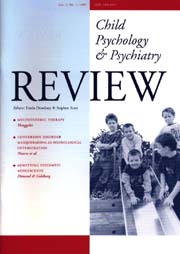Crossref Citations
This article has been cited by the following publications. This list is generated based on data provided by
Crossref.
Petersen, Larra
Kruczek, Theresa
and
Shaffner, Angela
2004.
Gender Roles and the Family Life Cycle.
Journal of Feminist Family Therapy,
Vol. 15,
Issue. 2-3,
p.
99.
Fishman, H. Charles
2006.
JUVENILE ANOREXIA NERVOSA: FAMILY THERAPY's NATURAL NICHE.
Journal of Marital and Family Therapy,
Vol. 32,
Issue. 4,
p.
505.
2009.
Bibliographie.
Le Journal des psychologues,
Vol. n° 265,
Issue. 2,
p.
55.
Byard, Katie
Fine, Howard
and
Reed, Jonathan
2011.
Taking a developmental and systemic perspective on neuropsychological rehabilitation with children with brain injury and their families.
Clinical Child Psychology and Psychiatry,
Vol. 16,
Issue. 2,
p.
165.
Carter, David J.
2011.
Case Study: A Structural Model for Schizophrenia and Family Collaboration.
Clinical Case Studies,
Vol. 10,
Issue. 2,
p.
147.
Weaver, Addie
Greeno, Catherine G.
Marcus, Steven C.
Fusco, Rachel A.
Zimmerman, Tina
and
Anderson, Carol
2013.
Effects of Structural Family Therapy on Child and Maternal Mental Health Symptomatology.
Research on Social Work Practice,
Vol. 23,
Issue. 3,
p.
294.
Byard, Katie
2015.
Neuropsychological Rehabilitation of Childhood Brain Injury.
p.
173.
Covelman, Kenneth
and
Brown, Nicole
2018.
Encyclopedia of Couple and Family Therapy.
p.
1.
Jérémie-Brink, Gihane
2018.
Encyclopedia of Couple and Family Therapy.
p.
1.
Covelman, Kenneth
and
Brown, Nicole
2019.
Encyclopedia of Couple and Family Therapy.
p.
1125.
Weaver, Addie
Greeno, Catherine G.
Fusco, Rachel
Zimmerman, Tina
and
Anderson, Carol M.
2019.
“Not Just One, It’s Both of Us”: Low-Income Mothers’ Perceptions of Structural Family Therapy Delivered in a Semi-rural Community Mental Health Center.
Community Mental Health Journal,
Vol. 55,
Issue. 7,
p.
1152.
Jérémie-Brink, Gihane
2019.
Encyclopedia of Couple and Family Therapy.
p.
1932.
Chappelle, Noelle
and
Tadros, Eman
2021.
Using Structural Family Therapy to Understand the Impact of Poverty and Trauma on African American Adolescents.
The Family Journal,
Vol. 29,
Issue. 2,
p.
237.
Tadros, Eman
2021.
Hierarchical Privilege and Power in Structural Supervision.
International Journal of Systemic Therapy,
Vol. 32,
Issue. 1,
p.
58.
Vu, Olivia
and
Saint-Jacques, Marie-Christine
2021.
Les frontières conjugales en contexte de recomposition familiale : l’expérience de beaux-parents vue sous un angle systémique.
Service social,
Vol. 67,
Issue. 1,
p.
11.
Pfeiffer, Simone
and
In-Albon, Tina
2022.
Comprehensive Clinical Psychology.
p.
185.
Tickle, Anna
2022.
Humble PIE: this is just the beginning.
Housing, Care and Support,
Vol. 25,
Issue. 3/4,
p.
190.
Mehta, Anita
and
Burley, Sarah
2022.
Blending family therapy modalities: creating structure through play.
Journal of Family Social Work,
Vol. 25,
Issue. 4-5,
p.
153.
ERYALÇIN, Münevver
ERYALÇIN, Talip
and
DUYAN, Veli
2022.
Denetimli serbestlik sisteminde aile temelli müdahale yöntemleri.
Turkish Journal of Family Medicine and Primary Care,
Vol. 16,
Issue. 2,
p.
434.
KURT, Ali Ammar
and
UZUN, N. Bilge
2023.
Development of Perceived Family Boundaries in Young Adults Scale.
Türk Psikolojik Danışma ve Rehberlik Dergisi,
Vol. 13,
Issue. 69,
p.
160.




